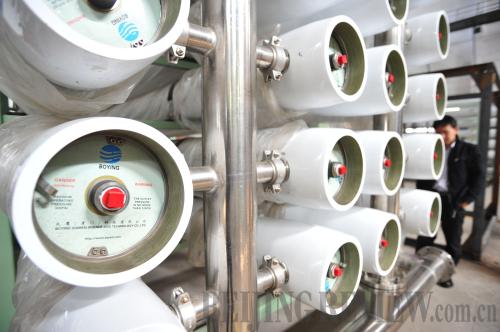|
 |
|
Seawater being processed to be drinkable in a desalination plant (WEI YAO) |
However, the handling capacity of the airport is limited by its single runway. Around 2017, passenger traffic at the airport is expected to reach the current limit of 27 million people, said insiders. The new airport under construction will handle the expected overflow of passengers. Scheduled to be completed by 2020, the new Xiang'an International Airport will have two runways and a terminal covering 540,000 square meters and handle about 45 million passengers per year. In the long run, two more runways will be added. Currently, both airports are mulling over opening new international flights to Southeast Asia and South Asia to facilitate communication along the Maritime Silk Road.
Traffic network by land enables Xiamen to radiate its commercial influence as an industrial hub along the Maritime Silk Road to China's vast inland areas. The city is one of China's nine largest logistics centers. In April 2010, the Fuzhou-Xiamen High-speed Railway officially opened, reducing the travel time from Fuzhou, capital of Fujian Province, to Xiamen to just 1.5 hours. "With the construction of the railway, Xiamen Island and the Yangtze and Pearl River Deltas are connected," said Zhu Qing, director of the Information Office of Fujian Province.
Pillar industries
Besides convenient transportation, Xiamen's position as an industrial hub is also reinforced by local pillar industries. "By 2018, the city will have nurtured 10 pillar industries, including logistics, tourism, manufacturing of flat play display (FPD), communication and machinery equipment, bio-tech & pharmaceuticals, new materials, software and information services, finance and innovation businesses. The yield of each industry will exceed 100 billion yuan ($16.7 billion)," said Zhang Zhihong, Deputy Director of Xiamen Municipal Development and Reform Commission.
In 2013, the output of FPD manufacturing, tourism and machinery equipment sectors in Xiamen amounted to 98.8 billion yuan ($16.1 billion), 80 billion yuan ($13.04 billion) and 70 billion yuan ($11.4 billion), respectively.
"As an island city, Xiamen is restrained by limited land and natural resources to develop the economy. Nurturing these pillar industries will help it overcome these difficulties by fully utilizing the resources, adding momentum to long-term economic development," said Xu Xiangqing, Director of Xiamen Municipal Development Research Center.
Ni Chao said the city supported further development of the marine economy. Besides facilitating sectors of ship manufacturing, fishing and cold chain logistics, Xiamen also encouraged research and development in marine biological technology to transfer the abundant marine resources to value-added products like medicines and healthcare food.
"Human resources and technology are of vital importance to the booming marine economy," said Ni. Action plans to attract research personnel and mechanisms to stimulate innovation have already been put in place.
In November 2012, the South Oceans Research Center was established in Xiamen. "[The launching of the center] initiated a new mechanism for applying research achievements to real production and became a bridge for exchanges and cooperation among government, businesses and research institutes," he said. |
